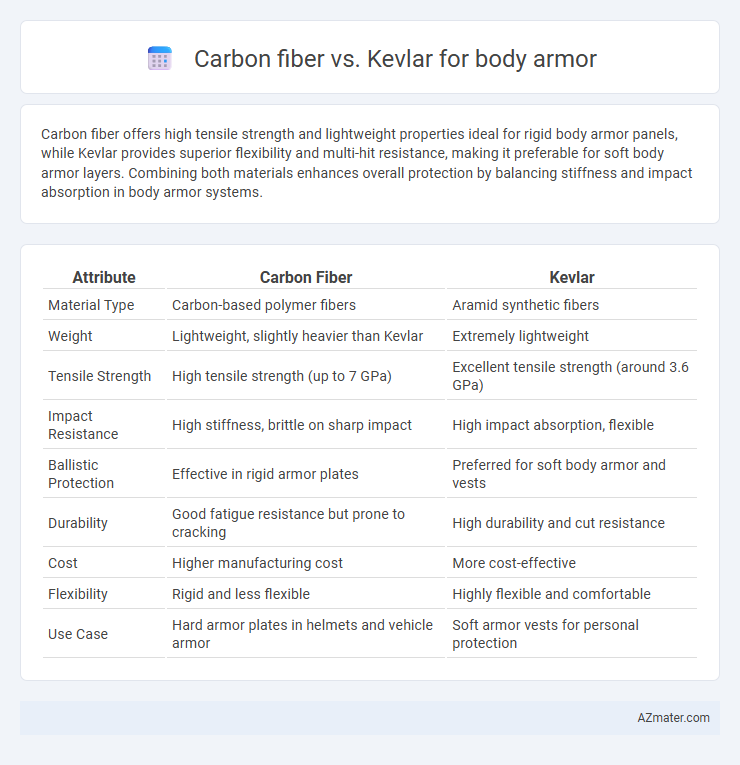Carbon fiber offers high tensile strength and lightweight properties ideal for rigid body armor panels, while Kevlar provides superior flexibility and multi-hit resistance, making it preferable for soft body armor layers. Combining both materials enhances overall protection by balancing stiffness and impact absorption in body armor systems.
Table of Comparison
| Attribute | Carbon Fiber | Kevlar |
|---|---|---|
| Material Type | Carbon-based polymer fibers | Aramid synthetic fibers |
| Weight | Lightweight, slightly heavier than Kevlar | Extremely lightweight |
| Tensile Strength | High tensile strength (up to 7 GPa) | Excellent tensile strength (around 3.6 GPa) |
| Impact Resistance | High stiffness, brittle on sharp impact | High impact absorption, flexible |
| Ballistic Protection | Effective in rigid armor plates | Preferred for soft body armor and vests |
| Durability | Good fatigue resistance but prone to cracking | High durability and cut resistance |
| Cost | Higher manufacturing cost | More cost-effective |
| Flexibility | Rigid and less flexible | Highly flexible and comfortable |
| Use Case | Hard armor plates in helmets and vehicle armor | Soft armor vests for personal protection |
Introduction to Body Armor Materials
Carbon fiber and Kevlar are two advanced materials commonly used in body armor for their unique properties. Carbon fiber offers exceptional strength-to-weight ratio and rigidity, making it ideal for lightweight, high-impact protection. Kevlar provides superior flexibility and ballistic resistance, allowing it to absorb and disperse energy from bullets and shrapnel effectively.
What is Carbon Fiber?
Carbon fiber is a lightweight, high-strength material composed of thin strands of carbon atoms tightly woven into a fabric and bonded with resin, widely used for its superior stiffness, tensile strength, and low weight. In body armor, carbon fiber provides enhanced impact resistance and durability without significantly increasing the overall weight, making it ideal for flexible and rigid protective gear. Unlike Kevlar, which relies on woven aramid fibers for ballistic protection, carbon fiber offers greater structural rigidity but lower energy absorption on impact.
What is Kevlar?
Kevlar is a synthetic aramid fiber renowned for its exceptional strength-to-weight ratio, making it a critical material in body armor for ballistic protection. Unlike carbon fiber, which offers high rigidity and stiffness, Kevlar provides superior flexibility and impact resistance, effectively absorbing and dispersing the energy from bullets and shrapnel. Its molecular structure, consisting of tightly woven polymer chains, enables Kevlar to withstand extreme forces while maintaining lightweight comfort for tactical and military applications.
Comparison of Strength and Durability
Carbon fiber offers exceptional tensile strength and stiffness, making it highly resistant to deformation under impact, while Kevlar excels in tensile strength combined with superior flexibility and energy absorption. Kevlar's woven structure dissipates energy effectively, providing better resistance to penetration and multi-hit capability compared to the more brittle nature of carbon fiber composites. Durability-wise, Kevlar maintains performance in harsh environments with excellent abrasion resistance, whereas carbon fiber composites can be more susceptible to impact damage and delamination over time.
Weight Differences: Carbon Fiber vs Kevlar
Carbon fiber body armor is significantly lighter than Kevlar, offering enhanced mobility and reduced fatigue for the wearer. Kevlar, while heavier, provides excellent flexibility and impact resistance, making it ideal for blunt force protection. The weight difference between carbon fiber and Kevlar can influence user performance and endurance during extended use.
Ballistic Protection Capabilities
Carbon fiber offers exceptional stiffness and lightweight properties but lacks the energy absorption needed for effective ballistic protection, making it less suitable for stopping high-velocity projectiles. Kevlar excels in ballistic protection due to its high tensile strength and ability to disperse impact energy, effectively preventing penetration by bullets and shrapnel. For body armor applications, Kevlar remains the preferred choice as it provides superior multi-hit resistance and enhanced durability under ballistic stress.
Comfort and Flexibility in Wear
Carbon fiber body armor offers high rigidity and strength but tends to be less flexible and can feel uncomfortable during extended wear due to its stiffness. Kevlar, known for its superior pliability and lightweight nature, provides enhanced comfort and greater freedom of movement, making it ideal for prolonged use. The flexible weave of Kevlar fibers allows better breathability and reduced chafing, which significantly improves wearer comfort compared to the more rigid carbon fiber composites.
Cost and Affordability Analysis
Carbon fiber body armor typically offers high strength and lightweight properties but comes at a significantly higher cost compared to Kevlar, making it less affordable for widespread use. Kevlar remains the industry standard for body armor due to its cost-effectiveness, balancing protection and affordability for military and law enforcement agencies. Budget constraints and production scale heavily influence the choice, with Kevlar providing a more economical solution without sacrificing essential ballistic resistance.
Real-World Applications and Use Cases
Carbon fiber offers superior rigidity and lightweight properties ideal for ballistic helmets and vehicle armor, enhancing mobility and protection against high-velocity projectiles. Kevlar excels in flexible body armor such as bulletproof vests, providing exceptional resistance to blunt force trauma and stabbing threats while maintaining comfort for law enforcement and military personnel. Combining both materials in composite armor systems enhances overall durability, impact absorption, and multi-threat protection in tactical and combat environments.
Future Trends in Body Armor Materials
Carbon fiber and Kevlar remain crucial materials in body armor, with future trends emphasizing hybrid composites that combine the high tensile strength of carbon fiber with the impact resistance of Kevlar for enhanced protection and flexibility. Advancements in nanotechnology and graphene integration aim to improve the lightweight properties and durability of these materials, enabling body armor to become thinner and more comfortable without compromising safety. Research into smart materials and self-healing polymers also promises to revolutionize body armor by offering adaptive protection and extended service life in various combat environments.

Infographic: Carbon fiber vs Kevlar for Body armor
 azmater.com
azmater.com